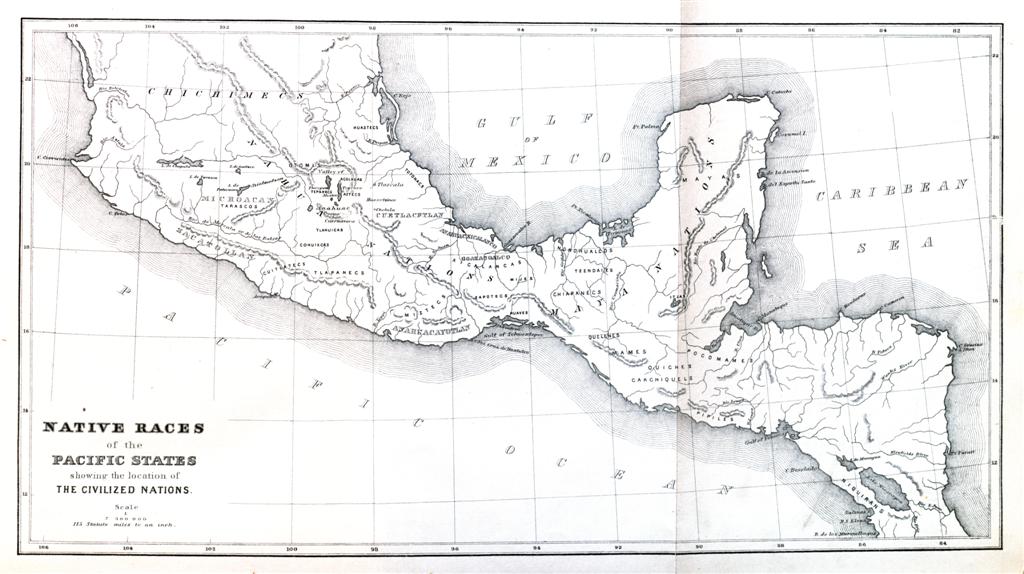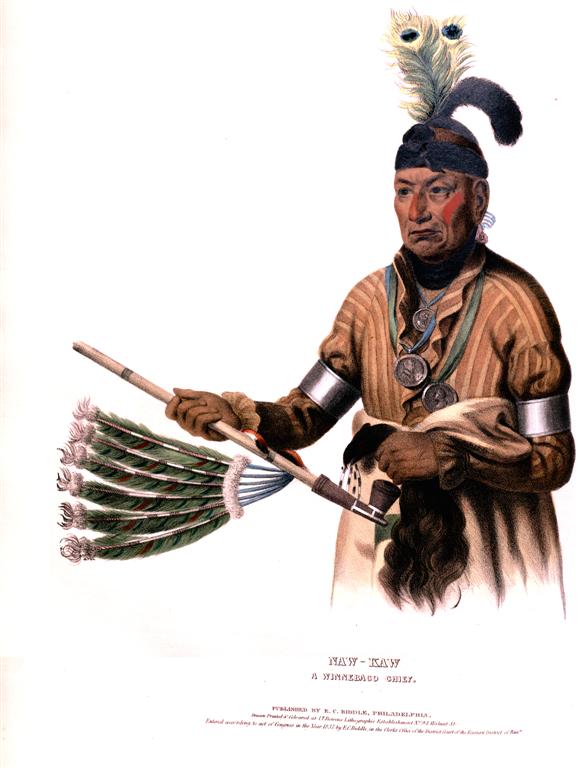|

|
Table
of Contents
Explorations
of the West
Sam
Dalsheimer
Caitlin
Goss
Nick
Schradle
David Sena
Representations
of
Native Americans
Richard
Dybas
Amanda Leong
Cynthia
Robertson
The
Western Railroads
Ronni Toledo
Kayt
Fitzmorris
Jon Ingram
David
Halperin
The
California
Gold Rush
Jordan Helle
Adam
Lawrence
Marisa
Pulcrano
Patrick Ryan
California
as Western Destination/
Mediterranean Boosterism
Maddy
Kiefer
Danielle
Mantooth
Molly
Nelson
Stefanie Ramsay
Other Online
Exhibits
|
Introduction
Representations of Native Americans
during the 1830’s and 1840’s were
literally and physically produced by
Thomas McKenney, Charles Bird King,
and James Hall in their series The
History of the Indian Tribes of
North America, with biographical
sketches and anecdotes of the
Principle Chiefs.[more]
This collection of portraits and
biographies of influential Native
American chiefs and leaders created
a government catalogue of Native
Americans with whom negotiation and
treaties took place. However, the
images and representations of the
Native Americans within the
collection set a stereotypical
reflection of and bunching together
of all Native Americans during this
time period, which continues to play
an important role in modern day
portrayal of Native Americans.
Henry Schoolcraft’s Information
Respecting the History Condition and
Prospects of the Indian Tribes of
the United States provides the
reader a broad view of the General
History, Mental Type, Antiquities,
Physical Geography, Tribal
Organization, Intellectual
Character, and Government Statistics
of all the recorded tribes of
Indians. These volumes provide
valuable first-hand drawings and
sketches of Indian artifacts,
written language, and villages drawn
by Captain S. Eastman. The
government records listed in these
editions covers the comprehensive
history of the Indians by source of
income, agriculture, amount of
workers, etc. Henry Schoolcraft
provides a great text for anyone
looking to find the History of
Indian tribes and information on
every facet of these tribes.
Within the extensive volume II of
The Works of Hubert Howe Bancroft:
Civilized Nations of his Native
Races collection, he clarifies, in a
rather ignorant manner, the
attainment of a civilized mind from
savagery, or the aggregate of Native
American peoples he chronicles. He
describes the binaries and absolutes
of civilization and savagery, often
in contradiction of previous
statements, whereby he associates
the disbelief in civilization
irrationally to choosing disease and
death over the wholesomeness of
health in life, for instance. The
term savagery, by his definition,
not only debases the Native American
position on the frontier as
desensitized and detached from the
significance of life, but portrays
them as lacking what the rest of
society, or non-Native settlers come
to “benefit” from, this rich,
comfortable, luxury called
civilization.
|
|

Information Respecting the
History Condition and
Prospects of the Indian
Tribes of the United
States

- Richard
Dybas
Henry
Schoolcraft published
Information Respecting the
History Condition and
Prospects of the Indian
Tribes of the United
States of American
Indians in 1847. This
extensive encyclopedia
provides an amazing piece of
research for anyone to use
for Indian research. The
first volume alone contains
sections on General History,
Mental Types of the Indian
Race, Antiquities of the US,
Physical Geography of the
Indian Country, Tribal
Organization, History and
Government, Intellectual
Character and Capacity of
the Red Man, and Population
and Statistics. Also, this
volume has an appendix which
contains Inquiries
respecting the history,
present condition, and
future prospects of the
Indian Tribes of the United
States. This specific work
owned by the Occidental
College Special Collections
library contains the rare
sixth volume of
Schoolcraft’s work. The
complete work goes into the
details of the vocabularies
of Indian languages,
grammatical analysis,
legends of various tribes,
biographies of chiefs and
warriors, narratives of
captivities, histories of
Indian Wars, emigrations,
and theories of their
origin. This publication
goes into the details of the
Psychology of Indians. It
shows the Orientalist view,
put upon the Indian during
the mid 19th
century. These volumes
provide a firsthand
Orientalist view into the
world of the Indians during
this time, which could prove
to be very valuable for
research in this area. [1]
Although, the reader must
make sure to note that this
was written and published
during a time, in which the
Indian standpoint was not
known or cared for. This is
shown by the psychology we
find in the second section
of the first volume. This
psychology goes so far as to
classify ancient traditions
of the Indians. The
psychology is very one sided
and does not seem to even
try to get an accurate
psyche of these Indian
tribes. Schoolcraft also
published many authentic
first hand drawings of
Indian artifacts, language
and miscellaneous items
drawn by Captain S. Eastman.
These drawings contain
weapons, domestic utensils,
instruments of gaming and
amusement, sorcery and
medicine, objects of
worship, Indian sculptures,
paintings and
fortifications, pictograph
writing, dwellings, and
every form of antiquities
which have been unearthed.
Schoolcraft essentially
provides researchers with
six volumes of incredibly
first hand information on
American Indians and every
facet of their
civilizations. And by doing
this makes sure that all
information on the American
Indians gathered by the mid
19th century
would be preserved in this
encyclopedia. Having this
work in the special
collections library at
Occidental provides a very
valuable work for anyone in
need of doing research on
the American Indian.
Return to Top
|
|

The Works of Hubert Howe
Bancroft Volume II The Native Races:
Civilized Nations

- Amanda Leong
Through an
idealist and orientalist
perspective BancrofT [1]
[2] applies his own ideas
of what savagism and
civilization entail in his
analysis of the Native
Americans’ status as
compared to the
“civilized” non-Native
inhabitants of the Pacific
Coast region mapped at the
front of this volume
II. He claims that
the natives become
increasingly more
civilized as time goes on,
emphasizing that this
societal pressure towards
“civilization” acts as a
necessity in the survival
of these peoples.
Somehow savagery means
making light of life’s
sufferings which Bancroft
assumes based on his
interpretations and
compilation of the
materials, documents, and
book sources he went about
Europe collecting
[3]. He tends to
explain the extravagance
of civilized society as a
perfect utopian
environment that could
never exist for the Native
Americans.
Bancroft’s civility relies
on the intention of
“purify the morals, to
give equal rights to man,
to distribute more equally
among men the benefits of
this world” and providing
a “means of accomplishing
a nobler destiny, to
increase the power of the
mind and give it dominion
over the forces of
nature.” 1
Like the cataloging of
Native Americans via
portraits [4], Bancroft
ignorantly makes claims
and assumptions about the
lifestyles of these Native
Americans. There is
no real face, as with the
portraits, to these
statements he makes but
rather establishes them as
a generality across all
groups of Native
Americans. But just
as the portraits emphasize
a red shade of skin in
each chief or woman
painted, Bancroft provides
them with a skewed,
desensitized attitude
about life implying that
these Indians know no
better. Also for
those within the tribes of
America, he claims them
more civilized than their
ancestors thereby
establishing gradations of
savagism within the
timeline of Native
American life.
In Bancroft’s
civilization, luxuries are
available to those
accepting civilized
lifestyle and all
assumptions associated
which he deems
inevitable. For
instance, he rather
shrewdly claims that to
reject civilizing oneself
would be to assume death
better than health. He
assumes a native person is
at least improved from the
savagery of initial point
of savagery: the primitive
Neanderthal. Among
his benefits to man he
assumes none of these
could have ever be made
available to a Native to
promote a more humane
society.
[1] Bancroft, Hubert
Howe. “Chapter I: Savagism
and Civilization.” In
The Works
of Hubert
Howe
Bancroft: Civilized
Nations, 2:2-51. San
Francisco: A. L. Bancroft
& Company,
Publishers, 1883
[2]
Said, Edward.
Orientalism.
Vintage Books, 1978.
[3] “The Bancroft
Collection.” The
Bancroft Library,
June 18, 2009. http://bancroft.berkeley.edu/collections/bancroft.htm
[4]
McKenney,
Thomas L. History of the
Indian Tribes of North
America, with
biographical
sketches…Philadelphia:
Frederick W. Greenough,
1838. (SC office and SC*
f: 970.1 M155h)
Return
to Top
|
|

History of the Indian
Tribes of North America, with
biographical sketches and
anecdotes of the Principle
Chiefs

- Cynthia
Robertson
"Introducing
and Reinforcing Stereotypes
of Native Americans"
Thomas McKenney was the
founder of the Bureau of
Indian Affairs, which was
established primarily to
create educational
institutions and to manage
the treaties of Native
Americans. While working at
the Bureau, McKenney decided
it would be helpful to
record information about the
Native Americans the Bureau
dealt with for future
interactions and trade.
McKenney employed Charles
Bird King to paint the
portraits of Native American
chiefs and people who
traveled to Washington, DC
for trade and negotiations.
These portraits became the
government’s collection of
images of important or
influential Indians and,
similar to a catalogue, were
eventually made into a set
of three volumes, each
containing 120 portraits,
with biographies written by
James Hall. The History
of the Indian Tribes of
North America, with
biographical sketches and
anecdotes of the Principal
Chiefs is essentially
the only remaining records
of what some early Native
American leaders looked
like, and a key piece of
evidence about what
stereotypes were typical of
this time, how they
developed, and how they
continue to exist. The
symbolism within the
portraits and the assumed
lifestyles recreated within
the text encourage the
audience to make
generalizations and
propagate potentially
problematic stereotypes
regarding Native Americans.
Although the Native
Americans within the
collection are diverse and
represented in a variety of
ways, a closer look at the
clothing, embellishments,
and objects, not to mention
facial features, leads the
reader to view the Native
Americans as different. Most
of the Native Americans are
pictured wearing textile
clothing, with feathers
attached, braids or
elaborate hairstyles,
extreme piercings, and face
paint. Similar to the
Orientalist discourse, these
portraits and the text
accompanying it reinforce
the “otherness” of Native
Americans while at the same
time producing similarities
amongst the different Native
American cultures, thereby
clumping them together
regardless of important
dissimilarities. This
collection seemingly treats
the Native Americans as
specimens in their book, by
providing definitions of
their lives that these
authors could know nothing
about. The people
represented in the
collection were important
figures, and played central
roles in the relationship
between the United States
Government and the Native
Americans in the 1830’s and
the 1840’s. These images
continue to be influential
in American society today as
they portray stereotypical
Native American portraits
and biographies and give the
reader a brief glimpse into
what was thought of as
Native American life.
Return
to Top
|
|
About
this Project / Acknowledgements
Occidental
College's "American Frontier"
Research Seminar was developed by
Dr. Jeremiah B.C. Axelrod, Adjunct
Assistant Professor of History.
The library project
is developed in collaboration with
the Special Collections
Department:
Dale Ann Stieber, Special
Collections Librarian
with student staff
Henry Boule and Claire Lem and
Laila Tootoonchi and Anahid
Yahjian.
Title Image:
Thomas Moran, "Nearing Camp,
Evening on the Upper Colorado
River, Wyoming, 1882," from
http://www.boltonmuseums.org.uk/collections/art/paintings_prints_and_drawings/oil/nearing_camp_moran
|
|
Page last edited on
03/12/2013.
Occidental
College Library Special
Collections & College Archives
© 2009 Occidental College
|
|
|
|
|